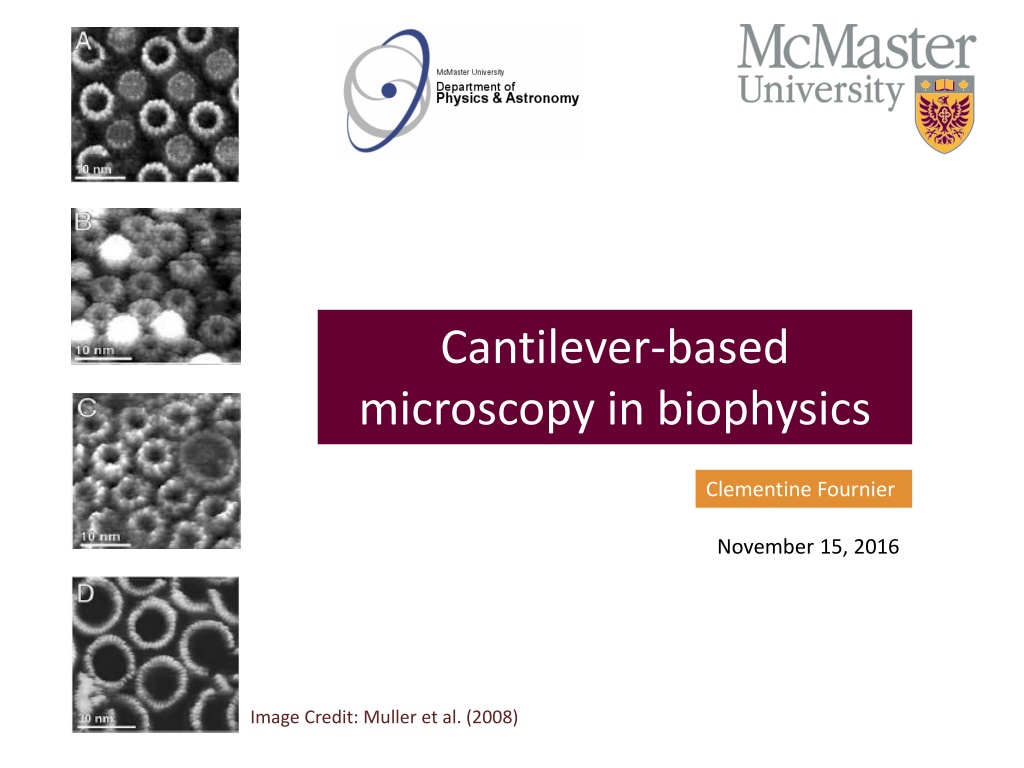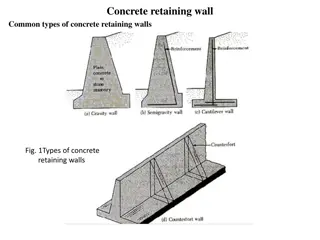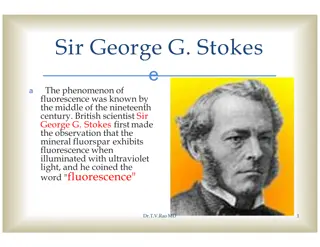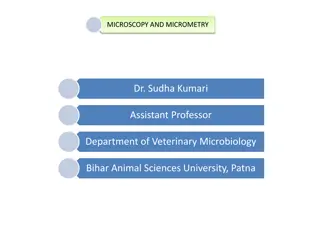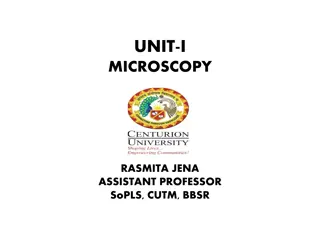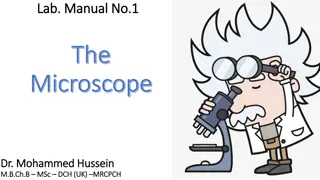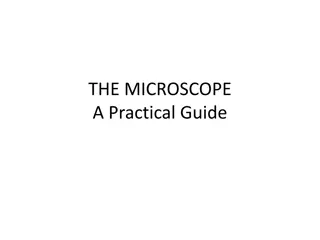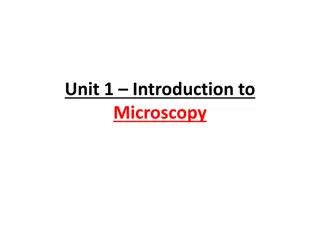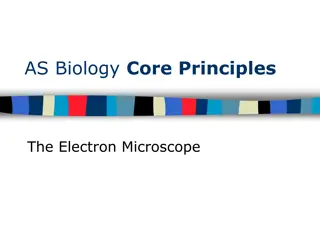Understanding Cantilever-Based Microscopy in Biophysics
Cantilever-based microscopy in biophysics explores the operating principles of an Atomic Force Microscope (AFM). It delves into high-resolution imaging and nano-force testing, with applications in biophysics. AFM works by measuring the interaction between the atom on the tip and atoms in the sample, detecting deflection of the cantilever. Ideal for in vitro biological applications, AFM can analyze samples ranging from single molecules to entire cells, providing detailed insights at the nanoscale level.
- Cantilever-based microscopy
- Biophysics
- Atomic Force Microscope
- High-resolution imaging
- Nano-force testing
Download Presentation

Please find below an Image/Link to download the presentation.
The content on the website is provided AS IS for your information and personal use only. It may not be sold, licensed, or shared on other websites without obtaining consent from the author. Download presentation by click this link. If you encounter any issues during the download, it is possible that the publisher has removed the file from their server.
E N D
Presentation Transcript
Cantilever-based microscopy in biophysics Clementine Fournier November 15, 2016 Image Credit: Muller et al. (2008)
Outline Cantilever-based microscopy in biophysics I. Operating principles of an Atomic Force Microscope (AFM) II. Two possible uses: high resolution imaging and nano-force testing III. Applications in biophysics 2
Outline Cantilever-based microscopy in biophysics I. Operating principles of an Atomic Force Microscope (AFM) II. Two possible uses: high resolution imaging and nano-force testing III. Applications in biophysics 3
Operating principles of an Atomic Force Microscope (AFM) How does an AFM work? Image Credit: Department of Materials, ETH Zurich Image Credit: Physics Department, Warwick University 4
Operating principles of an Atomic Force Microscope (AFM) How does an AFM work? Operating principle? Interaction between the atom on the edge of the tip and the sample s atoms Signal measured? Deflection of the cantilever upon tip-sample interaction Force resolution? A few piconewtons Operating conditions? In air or liquid environments At every temperature around ambient 5
Operating principles of an Atomic Force Microscope (AFM) What kind of samples for this technique? AFM = Ideal for in vitro biological applications Samples range from single molecule to entire cell Image Credit: De Oteyza et al. (2013) Image Credit: Princeton University, Sarah Pfau Image Credit: Fairman studio LLC 6
Outline Cantilever-based microscopy in biophysics I. Operating principles of an Atomic Force Microscope (AFM) II. Two possible uses: high resolution imaging and nano-force testing III. Applications in biophysics 7
Two possible uses: high resolution imaging and nano-force testing High resolution imaging AFM: topography recorder Result: 3D mapping of a sample and height profile Resolution: nano-scale more recently angstrom-scale Image Credit: De Oteyza et al. (2013) Image Credit: Muller et al. (2007) 8
Two possible uses: high resolution imaging and nano-force testing Force spectroscopy AFM: nanomechanical tester Possible applications: Friction measurement, micro- lithography, acquisition of force-distance curves. Image Credit: Galajda et al. (2015) Example: Vinckier, Semenza (1998) Young s modulus calculation for cells or microtubules. 9
Outline Cantilever-based microscopy in biophysics I. Operating principles of an Atomic Force Microscope (AFM) II. Two possible uses: high resolution imaging and nano-force testing III. Applications in biophysics 10
Applications in biophysics From single molecules to cells mapping One example : Muller et al. (2008) Observation of native membrane proteins at work Picture: Communication channels from rat liver cells. Gap junctions closing due to pH change. Image Credit: Muller et al. (2007) 11
Applications in biophysics From single molecules to cells mapping Another example: Light-driven proton pump bacteriorhodopsin (BR) Removal of one BR : global rearrangements Image Credit: Muller et al. (2007) 12
Applications in biophysics Using bio-recognition Cantilever-based biosensors Receptor-ligand binding tester Example: Florin et al. (1994) Finding the receptor-ligand unbinding force between biotin and avidin using a force- displacement curve Image Credit: Florin et al. (1994) 13
Applications in biophysics Cantilever-based biosensors Biofunctionalized cantilevers: similar to the AFM. Binding of molecules to the surface alters the surface free energy Ligands Image Credit: Phillips et al., Physical biology of the cell, Garland Science 14
Applications in biophysics Cantilever-based biosensors Example : Fritz et al. (2000) Monitoring single strand DNA hybridization with two microcantilevers in parallel System able to detect a single base mismatch Image Credit: Fritz et al. (2000) 15
Applications in biophysics But also Cellular biomechanics Cell-cell interactions Image Credit: Liu et al. (2010) 16
References Mowbray DJ, Etkin G, Pedramrazi Z, Tsai HZ, Rubio A, Crommie MF, Fischer FR (2013) Science 340:1434-1437. Muller DJ, Engel A, (2007) Curr Opin Colloid Interface Sci Vinckier A, Semenza G (1998) FEBS Lett 430:12-16. Florin EL, Moy VT, Gaub HE (1994). Science 264:415- 417. J. Fritz, M.K. Baller, H.P. Lang, H. Rothuizen, P. Vettiger, E. Meyer, H.-J. G ntherodt, C. Gerber, J.K. Gimzewski, (2000) Science 288 316 318. Liu Y, Pinzon-Arango PA, Gallardo-Moreno AM, Camesano TA (2010) Mol Nutr Food Res 54:1744-1752. De Oteyza DG, Gorman P, Chen YC, Wickenburg S, Riss A, Image Credit: Muller et al. (2007)
Thank you! Questions? Image Credit: Muller et al. (2007)
